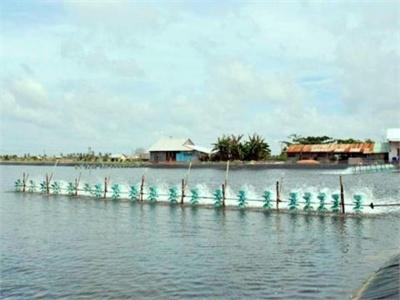Tác Nhân Gây Bệnh Hoại Tử Gan Tụy Cấp Tính Đã Được Nhận Diện

Theo thông tin báo cáo từ trang web: AquaticHealth.net thì tác nhân gây bệnh hoại tử gan tụy cấp tính ở tôm đã được nhận diện là Vibrio parahaemolyticus bị chèn phage. Nguồn thông tin khác từ GAA (Global Aquaculture Alliance) thì GS. Lightner cũng đã công bố kết quả tác nhân gây bệnh EMS là 1 chủng vi khuẩn lây nhiễm cao của loài Vibrio parahaemolyticus bị nhiễm Virus hay còn gọi phage làm cho vi khuẩn này phóng thích độc tố hủy hoại gan tụy và cơ quan tiêu hóa của tôm - chủng vi khuẩn này khu trú trong hệ thống tiêu hóa của tôm.
Nguồn thông tin theo các báo cáo dưới đây:
early mortality syndrome ~ EMS
Article Content
Intrafish Reports
http://www.intrafish.com/news/article1369134.ece
You will need to subscribe to read this article.
Identified cause: Vibrio parahaemolyticus with phage
May 1, 2013
United States
Arizona—Dr. Lightner Finds the Cause of EMS
On May 1, 2013, the Global Aquaculture Alliance (GAA) reported that Dr. Donald Lightner, the famed shrimp pathologist at the University of Arizona, had found the cause of early mortality syndrome (EMS), a disease that is costing the shrimp farming industry a billion dollars a year.
Lightner’s team found that EMS is caused by a unique strain of a relatively common bacterium, Vibrio parahaemolyticus, that is infected by a virus known as a phage, which causes it to release a potent toxin. The bacterium is transmitted orally, colonizes the shrimp gastrointestinal tract and then produces a toxin that causes tissue destruction and dysfunction of the hepatopancreas, the shrimp’s digestive organ.
Research continues on the development of diagnostic tests for rapid detection of EMS that will enable improved management of hatcheries and ponds. It will also enable a better evaluation of the risks associated with importation of frozen shrimp or other products from countries affected by EMS.
Some countries have implemented policies that restrict the importation of frozen shrimp or other products from EMS-affected countries. Lightner said frozen shrimp likely pose a low risk for contamination of wild shrimp or the environment because EMS-infected shrimp are typically very small and do not enter international commerce. Also, his repeated attempts to transmit the disease using frozen tissue were unsuccessful.
In an effort to learn from past epidemics and improve future policy, the World Bank and the Responsible Aquaculture Foundation, a charitable education and training organization founded by the Global Aquaculture Alliance, initiated a case study on EMS in Vietnam in July 2012. Its purpose is to investigate the introduction, transmission and impacts of EMS, and recommend management measures for the public and private sectors.
Information: Media Inquiries, Steven Hedlund, GAA Communications Manager (phone +1-207-831-0196, emailsteven.hedlund@gaalliance.org); Technical Questions, George Chamberlain, GAA President (phone +1-314-607-8466, email georgec@gaalliance.org).
Information: Donald V. Lightner, Department of Veterinary Science and Microbiology, The University of Arizona, Building 90, Room 102,117 E. Lowell Street, Tucson, Arizona 85721, USA (phone 1-520-621-4438, fax 1-520-621-4899, email dvl@email.arizona.edu, webpage http://www.microvet.arizona.edu/research/aquapath/index.htm).
Source: 1. Global Aquaculture Alliance. Press Release. Cause of EMS Shrimp Disease Identified. May 1, 2013.
Related news
 Mô hình kỹ thuật nuôi cua đồng
Mô hình kỹ thuật nuôi cua đồng Dự án khuyến nông đồng bằng sông Cửu Long do Trường đại học Cần Thơ làm chủ dự án đã triển khai thực hiện nhiều mô hình chăn nuôi ở xã nông thôn mới Mỹ Thọ huyện Cao Lãnh, Đồng Tháp. Trước đây là mô hình chăn nuôi heo nái hướng nạc, kế đến là mô hình nuôi vịt siêu thịt và đến nay là mô hình nuôi cua đồng.
 Kỹ thuật nuôi cua lột
Kỹ thuật nuôi cua lột Cua xanh (Scylla serrata) là một loại cua biển có kích thước tương đối lớn, có giá trị kinh tế cao của nước ta. Cua xanh sống vùng nước lợ như rừng ngập mặn cửa sông ven biển và nó có khả năng thích ứng cao với sựthay đổi độ mặn của nước.
 Kỹ thuật nuôi cua con thành cua thịt
Kỹ thuật nuôi cua con thành cua thịt - Xây dựng ao nuôi : Ao nuôi cua con thành cua thịt thường theo hình thức nuôi thâm canh có diện tích từ 500m2 đến 5000m2, nên chọn vùng dễ thay nước nhờ vào thuỷ triều để giảm chi phí, nguồn nước đảm bảo vệ sinh.
 Kỹ thuật nuôi cua đồng
Kỹ thuật nuôi cua đồng Cua đồng là đối tượng thủy sản quen thuộc, gắn bó với bà con nông dân của chúng ta từ xưa đến nay. Nuôi cua đang là một nghề mới rất hấp dẫn người dân và rất có tiềm năng. Cua sống hoang dã, rất ít bệnh tật nhưng khi đưa vào nuôi với mật độ cao hơn so với ngoài tự nhiên; cũng cần một số biện pháp kỹ thuật để đạt hiệu quả kinh tế cao.
 Đặc điểm sinh học của cua biển
Đặc điểm sinh học của cua biển Cua biển có tên tiếng Anh là mud-crab, green crab, hay mangrove crab; tên tiếng Việt gọi là cua biển, cua sú, cua xanh, cua bùn, loài phân bố chủ yếu ở vùng biển nước ta là loài Scylla paramamosain (cua sen) và loài Scylla olivacea (cua lửa). Hai loài nầy là một trong những loài cua biển có kích thước lớn.